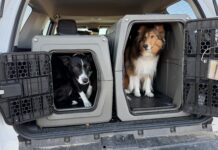I got my first dog, a stray that I begged my mother to allow me to keep, when I was 9 years old. It was 1964, on Long Island, New York. I had been playing in the cul-de-sac with friends when this little black and tan puppy came bounding up to us. We became best friends, and I was hell-bent on keeping her. My parents were separated, and my mother wasn’t in the best of moods, but my siblings convinced my mother to let me keep her. We needed each other and on some level my mother knew this.
Since then, I’ve never been without at least one canine companion – usually I have two or three – and they’ve all been strays, hard-to-place dogs from a rescue organization, or given to me by a frustrated client. In more than 50 years (56 years, actually), I have never once searched for a dog; they showed up in my life when they needed a home. Heck, even my horses, cats, and chickens have all been rescued animals.
But now, at the age of 65, I did something that I’ve never done before: I bought a purebred puppy.
WHEN BUYING A PUPPY MAKES SENSE
I had a number of reasons for my purchase; it wasn’t an impulse buy. It probably surprised people who know me as a lifelong proponent of rescuing pets, but I’m actually very supportive of well thought-out and responsible purebred puppy purchasing – that is, under a set of specific conditions:
■ The buyers know what they want and are familiar with or at least knowledgeable about the type of dog they want. In other words, they’ve done extensive research on health issues, appearance and coat maintenance, temperament, energy level, and typical behavioral traits for their desired breed.
■ The flip side of this: If a person admires how a certain breed of dog looks, but isn’t familiar with and appreciative of their temperament and how this dog typically behaves, it would behoove them to do a bit more research, to make sure it fits with their lifestyle or it is certain to be a set up for failure.
■ The buyers have done the necessary groundwork for the breed they desire and will be able provide an appropriate home for the type of dog they want. They should be confident that they are well-suited to manage a dog with the breed’s typical characteristics, energy level, and temperament. This includes health issues and care and maintenance of the dog’s coat.
■ The flip side of this: The family wants a specific breed that is more than likely to fail if it only meets the criteria of looks, not lifestyle. For example, inactive people, living in a condo with no yard, who love the look of an Australian Shepherd, probably shouldn’t get an Aussie. Australian Shepherds need plenty of physical exercise as well as a great deal of mental stimulation to keep them busy and happy.
■ The buyers specifically want a puppy. They are passionate about raising a dog from the earliest age possible and are ready to alter their lives and schedules in order to accommodate a puppy’s extraordinary needs for guidance and exercise.
■ The flip side of this: The buyers are under the assumption that a puppy can be crated for many hours each day and won’t require much alteration or adjustment on the part of their daily routine. They feel that they won’t need to do much in the way of puppy-proofing their home because the puppy will be crated, which is also not considering the emotional needs of the puppy or the ability to teach manners when they are locked in a crate all day.
■ The buyers are ready for a puppy. They are equipped with puppy pens and baby gates and a wealth of puppy toys. They have a veterinarian and have pre-enrolled in a puppy training/socialization class and know that training continues through adolescence into adulthood. They have plans for puppy play dates with dogs who are well matched in size, breed, and age.
■ The flip side of this: They’ve had dogs before but haven’t had a puppy in 20 years and think they’ve got it all covered, but they haven’t found a veterinarian yet. They think their old dog’s toys will suffice. They aren’t aware of the modern, science-based changes in training theory and methods, so they don’t realize that not all trainers are alike.
■ The buyers have found a responsible and ethical breeder. This person makes appropriate placements only, taking care to match the buyers with puppies who are well-suited to that puppy’s emerging temperament.
■ The flip side of this: Buyers are unaware of what a responsible breeder is, don’t know what questions to ask, so they have been searching online, on Craigslist and Facebook Marketplace, or calling pet stores to find out if they have puppies. They are unaware of what a puppy mill is and think that buying a puppy sight unseen from a website is legit. They don’t know that these breeders will sell to anyone with the money to buy, with little to no concern for the welfare of the puppy or how well matched they are with the buyers.
WHEN RESCUE MAKES MORE SENSE
There is a big division in the dog community about rescuing: To those of us who work in rescue, it can seem irresponsible to buy a purebred dog when there are so many dogs waiting in shelters or foster homes, in desperate need of a forever home.
Let’s face it, money exchanges hands with both shelters and breeders. It’s takes money to care for animals. Compensation is necessary. Money drives both transactions and the onus is on us to do our due diligence in finding those who really have the welfare of the animals as their first priority.
Sometimes, a dog’s appearance matters far less to a prospective owner than an individual dog’s personality and temperament. One huge benefit of adopting a “recycled” adult dog is that his size, coat, and personality is already fairly established. (Rescued puppies are a bit more of a gamble in terms of eventual size!)
When a family is open to rescuing a dog, their list of considerations may look more like the ones below. (Keep in mind that this list absolutely applies to people who think they want to buy a purebred dog, too.)
■ Overall, will the prospect be a good fit for our family’s lifestyle? For example, physically fit, curious, confident dogs might be best for active families; quiet dogs are likely to be more content as a companion to a less-active person, perhaps living in an apartment, happy to go on daily walks and not much more.
■ Does the prospect likes children and/or other animals, including other dogs? If the adopter has children and/or other animals, this needs to be positively determined.
■ Does the dog have the fitness and temperament to participate in whatever sports the owner enjoys?
■ Is the dog a good size for the owners? For example, older people may want a dog who is small enough to lift and carry if need be and who won’t be difficult to walk even if the dog pulls (but perhaps not so small as to be tripped over). Other families specifically want a big dog.
■ Is the dog protective, a “guarding” type? Is this appropriate for this home, with children and friends coming and going?
■ If the dog has health issues, or is a breed with a strong propensity for inherited health issues, are they affordable for the family? Will the dog need a special diet to prevent allergies, daily medication for arthritis, heartworm treatment? If he’s handicapped in some way (blind, partially paralyzed, etc.), is the family able to accommodate his disabilities?
■ Does the dog have behavioral issues that will require time, accommodation, management, and/or training? Be aware that many dogs end up in shelters because of a behavioral issue that someone else couldn’t or wouldn’t deal with. Are they willing to do the training and behavior modification to alleviate whatever caused the issues?
OWNING A DOG REQUIRES WORK EITHER WAY
I am acutely aware that many dogs who have been rescued from abandonment or surrendered may require a lot of time and extra work to help them fit into our society; for the past 50 or so years and until now, every single one of my dogs has been previously owned.
But even though I’ve now bought a puppy who has more of a “blank slate” than I’ve ever had the pleasure of bringing home, I know there are no guarantees that she will develop into a healthy, perfectly well-behaved lifelong companion. All dogs require a commitment of time, money, love, and effort.
Here’s the difference: I’m aware that no matter what behavioral or health baggage dogs come with, when we enter into a relationship well prepared and with our eyes open, and we completely accept responsibility for their well being, with kindness and patience, we can not only learn to live with each other in harmony, but thrive.
MY INFORMED DECISION
I chose to get a Rottweiler puppy, and I had a few reasons for this.
First, I was down to one dog, Timber, a 10-pound mixed-breed. Previously, I’ve never had just one dog and never had a dog smaller than 30 pounds. I hike every day and haven’t felt safe hiking with just Timber, who would be no more than a little snack to predators like coyotes and bobcats. I wanted a second dog again, and a big dog, one who would be capable of being Timber’s and my protector on trails, with the stamina to do long and challenging hikes. I also live alone and having a big dog makes me feel a lot more safe.
Second: I’ve had a Rottweiler in mind for ages. About 40 years ago, I had a Rottweiler, Ninja, who was given to me. At the time, I worked closely with a therapist who worked with troubled teens and Ninja helped us immensely with those kids. They all loved playing with, grooming, and training the 125-pound goofball of a Rottweiler. They could relate to the big dog who looked tough on the outside but was meek and a bit silly on the inside. For years, I thought that when my own children grew up and I was winding down my career in dog training that I would seriously revisit getting another Rottweiler to be a therapy dog for troubled teens.
Timber and I had been alone for a year when I saw a pictures and video posts on social media of a Rottweiler puppy that a colleague was training. I couldn’t get enough of watching their training progress. I realized that I was now ready to do what I had wanted to do since Ninja died in the early ’90s.
Also, I wanted a purebred puppy whose history, genetics, temperament, and breed characteristics were known. While puppies already have a fair amount of writing on their slates when they go to their forever homes, I wanted to start with as clean a slate as possible given my desire to do therapy work with teenagers. There are no guarantees when getting a dog, whether we purchase from an ethical and responsible breeder or adopt a puppy from a shelter, but I knew that if I did my due diligence as a buyer, I’d have a better chance of getting a solid temperament and healthy puppy from someone who did their due diligence as a breeder.
THE RIGHT ONE

I wasn’t actively looking, but after being riveted by the social media appearances of my colleague’s pup, I mentioned to a friend that I wanted a Rottie puppy. Without hesitation, she told me about an acquaintance who trains and breeds service and therapy dogs – and who had a Rottweiler puppy that he wanted to go to a trainer who wants to train a therapy dog. I had to reach out.
I contacted the breeder and asked about the puppy he thought was a good therapy dog prospect. We talked for over an hour and I heard about all the work and time that he put into this litter. I realized that this was the pup for me. I was getting a Rottweiler puppy who will become my next therapy dog.
This man takes his job as a breeder seriously and has educated himself in how he can help his puppies succeed before they go to their perspective homes. And since he’s also a trainer of service and therapy dogs, I knew he breeds for temperament and provides early enrichment training and socializing that enhances the potential for the puppies’ success. For me, temperament is number 1 on my wish list, with early enrichment a close second; this litter had both.
Leela means “play” in Sanskrit and that’s what I hope my new puppy brings to those in need, a sense of play. She is now 7 months old, and I couldn’t be happier with who she’s becoming. The breeder’s great choices in selecting her parents, and the early neurological stimulation (ENS) exercises he did with the entire litter went a long way toward making her who she is today: a loving, willing, and confident dog who is very interested in people and already has a keen sense of knowing who needs her energy. I’m hopeful by the time she’s ready, this pandemic will be a thing of the past and we can begin our journey to helping heal some kids who could really use her generous, kind, and loving spirit.






I’m looking to buy or adopting a dog can be lab or rodwailer what people recomend me..
What a wonderful, balanced article. Leela is a beauty – happy hiking with your pack!
Good luck with your new dog. I have a Schipperke, my fourth Schip. I have both bought from breeders and taken rescue dogs of various breeds. I’ve been very fortunate; they’ve all been wonderful dogs who died too soon.
“I have never once searched for a dog; they showed up in my life when they needed a home. ” – Beautiful and relatable words. The best article I’ve read so far on ‘dog behavior expertise’. Kudos to you ma’am, Jill Breitner!
My last dog, Gracie, was my first purebred. She was a German Shepherd and I knew she would be my last large dog. I did a lot of research (2 years) and found a breeder whose Shepherds were therapy dogs, even though I didn’t intend to train her to be one. She was a handful for the first year, but turned out to be beautiful, inside and out. I fed her human-grade food, only let her gave vaccinations she needed, and she thrived under my care. But at eight years old, one day she threw up all her food, and then all the water. An x-ray showed a blockage and exploratory surgery was needed. She had a tumor within the pancreas and it was inoperable. From the beginning of her throwing up to the end, it was 3 days and I lost her. I’m still in shock. It wasn’t genetics, it was just a bad break for my poor angel. But I regret nothing. Gracie was beloved by my family and she gave back all the love and devotion we could ask for. I have begun my research for a smaller dog. I will get another purebred from a breeder because I can find out everything about the pup’s parents, the breeder, ask for references from other owners, ask about health issues particular to the breed — and if I don’t get sufficient answers, then I move on. I just like to know, as best as I can, what makeup of pup I’ll get. I’m looking forward to it.
I’m like you, Jill, in that I’ve had a whole lifetime of rescues and only rescues. Turned 65, and suddenly I feel it’s okay for me to purchase the one dog breed with characteristics that are a perfect match for me because I just can’t do yappy little dogs anymore. And I do need a little dog. I’m still grieving my last little Papillon rescue who passed last year and just can’t do it again. It just hurts too much. So it’s this breed or nothing. I searched so many rescues and shelters across the country and couldn’t find ANY, never mind THE ONE. So I went through the Spanish Inquisition with a reputable breeder, and lo and behold…. I am picking up my Biewer Terrier on July 18th when she turns three months old.
Now the problem. What in the world do I tell my relatives, friends, and neighbors when they had their fill years ago of listening to me, the biggest cheerleader for rescues–never purchased, and here I am BUYING a dog. Shall I just admit to hypocrisy? Or plead the 5th? Maybe one day when they get to be little old ladies and gentlemen, they can get away with all kinds of Red Hat Society stuff, too, that they would have never dreamed of doing in their younger years. Questions, comments, rebuttals, or suggestions welcome.
Tish Reiver